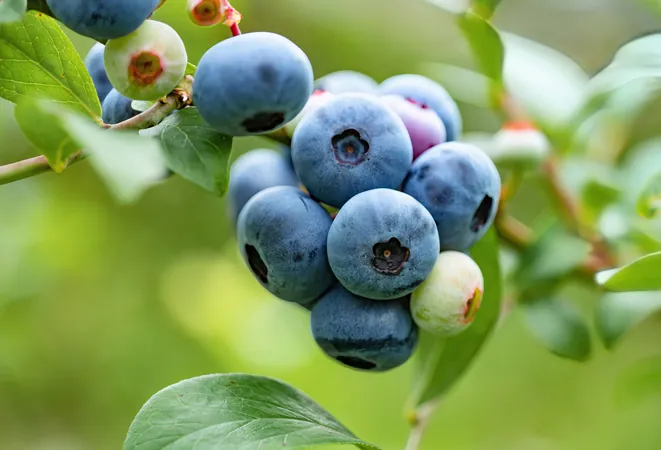
Blueberry Farmers Face Global Threat: Powdery Mildew Disease Spreads Rapidly
2025-01-09
Author: Wei Ling
Imagine a picturesque blueberry farm, where lush green bushes are laden with plump, sweet berries glistening in the sun. Sadly, this idyllic scene is at risk as a new adversary looms on the horizon.
Blueberry plants worldwide are under siege, their vibrant colors fading and growth hampered by a white, powdery fungus known as Erysiphe vaccinii, the culprit behind the devastating disease known as powdery mildew.
A groundbreaking study from North Carolina State University has revealed the alarming fact that Erysiphe vaccinii has been rapidly spreading around the globe over the past 12 years, wreaking havoc on blueberry plants initially found in the eastern United States.
“We are witnessing the expansion of this fungal invasion right before our eyes,” remarked Michael Bradshaw, an assistant professor of plant pathology at NC State. The fight against this fungus is not just about aesthetics – the powdery mildew has dire consequences on the quality and quantity of blueberry crops.
The fungus coats affected plants in a white layer, severely disrupting their ability to perform photosynthesis, which reduces light absorption and siphons critical nutrients needed for growth. This deterioration leaves blueberry plants weakened and less productive, ultimately causing a decline in blueberry yields.
Global Spread of the Fungal Threat
The study utilized 173 samples of infected blueberry leaves, some dating back over 150 years, sourced from various countries. Through genetic analysis, researchers uncovered that the strains causing the current outbreaks are new and distinct from those seen in older specimens. Shockingly, these strains have traveled far beyond their origins, reaching as far as China, Mexico, California, Morocco, Peru, and Portugal.
Bradshaw emphasized the role of human activity in this concerning spread, pointing out that the global trade in plant materials can inadvertently transport these harmful pathogens. “By sending infected nursery plants across borders, we are likely amplifying this fungal problem,” he stated, underscoring the risks involved with international plant trade.
Economic Ramifications for Blueberry Growers
The consequences of powdery mildew are not just environmental; they have significant financial implications for farmers. Estimates indicate that the disease could cost the blueberry industry between $47 million and $530 million annually due to the increased needs for fungicide applications and potential reductions in crop yields.
Regions like the U.S. Pacific Northwest are currently at high risk for outbreaks, with environmental conditions that are suitable for the disease to thrive. Despite the absence of reported cases in those areas so far, proactive measures for monitoring and control are essential to fend off future invasions.
Bradshaw pointed to agricultural practices as a contributing factor to the severity of the disease. "Areas that grow blueberries in tunnel systems often face more severe outbreaks than those that grow the fruit outdoors without protection,” he explained, highlighting the importance of environmental awareness in farming tactics.
A Resource for Farmers
In a bid to assist farmers in battling powdery mildew, researchers have developed a public database that allows growers to identify different fungal strains. By entering data about affected crops, farmers can determine the specific strain of powdery mildew impacting their fields, which is crucial for devising effective intervention strategies.
“The more our farmers know about the nature and behavior of the strain they're dealing with, the better they can tailor their control measures,” Bradshaw noted, emphasizing the importance of understanding the genetics behind the disease.
As this research underscores the urgent need for improved monitoring and control strategies, it offers glimmers of hope for the blueberry industry to safeguard itself against the rapidly spreading powdery mildew. The study was supported by the National Science Foundation and the Novo Nordisk Foundation and is published in the journal *New Phytologist*.
Stay informed and protect your blueberry harvests as this global crisis unfolds!

 Brasil (PT)
Brasil (PT)
 Canada (EN)
Canada (EN)
 Chile (ES)
Chile (ES)
 Česko (CS)
Česko (CS)
 대한민국 (KO)
대한민국 (KO)
 España (ES)
España (ES)
 France (FR)
France (FR)
 Hong Kong (EN)
Hong Kong (EN)
 Italia (IT)
Italia (IT)
 日本 (JA)
日本 (JA)
 Magyarország (HU)
Magyarország (HU)
 Norge (NO)
Norge (NO)
 Polska (PL)
Polska (PL)
 Schweiz (DE)
Schweiz (DE)
 Singapore (EN)
Singapore (EN)
 Sverige (SV)
Sverige (SV)
 Suomi (FI)
Suomi (FI)
 Türkiye (TR)
Türkiye (TR)
 الإمارات العربية المتحدة (AR)
الإمارات العربية المتحدة (AR)